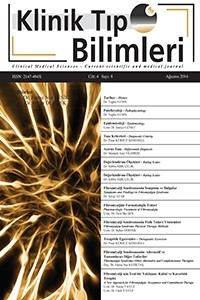13 Yaşında Hiperglisemili Olgu
ÖzÇocuk ve adolesan çağında hiperglisemi hemen daima Tip-1 diyabet e bağlıolarak görülmekte ise de obezite epidemisine paralel olarak tüm dünyada artış gösteren Tip-2 Diyabetes Mellitus (Tip-2DM) olguları giderek daha erken yaşlara kaymaya başlamış ve artık adolesanlarda da görülmeye başlamıştır. Öte yandan gelişen moleküler biyoloji teknikleriyle MODY olguları da artan oranda tanınır hale gelmektedir. Adolesanlardaki Tip-2DM yi çocukluk çağında daha sık görülen Tip-1DM den ve MODY den ayırmak hem klinik yaklaşım, hem prognoz açısından önemlidir.
Anahtar Kelimeler:
Diyabetes Mellitus, Tip-2diyabet, Obezite, insülindirenci
13 Year Old Patient with Hyperglycemia
AbstractWhile hyperglycemia during childhood and adolescence is almost always caused by Type 1 diabetes, paralelled to the obesity epidemic. paralleling to the increasing obesity rates, the diagnosis of Type 2 Diabetes is shifting towards younger ages. On the other hand, advancement in molecular biology techniques made MODY cases more recognizable. It is important to differentiate T2DM from T1DM which is the most common form of Diabetes in the pediatric age group, as wellas from MODY due to considerations in clinical and therapeutic approach andprognosis
Keywords:
Diabetes Mellitus, Type-2diabetes, obesity, insülinresistance,
___
- Kaynaklar 1.Dabelea D, Mayer-Davis EJ, Saydah S, et al. Prevalen-ce of type 1 and type 2 diabetes among children and ado-lescents from 2001 to 2009. JAMA 2014; 311:1778. 2.Pinhas-Hamiel O, Dolan LM, Daniels SR, et al. Increa-sed incidence of non-insulin-dependent diabetes melli-tus among adolescents. J Pediatr 1996; 128:608. 3.Writing Group for the SEARCH for Diabetes in YouthStudy Group, Dabelea D, Bell RA, et al. Incidence of dia-betes in youth in the United States. JAMA 2007;297:2716. 4.Urakami T, Kubota S, Nitadori Y, et al. Annual inciden-ce and clinical characteristics of type 2 diabetes in child-ren as detected by urine glucose screening in the Tok-yo metropolitan area. Diabetes Care 2005; 28:1876. 5.Likitmaskul S, Kiattisathavee P, Chaichanwatanakul K,et al. Increasing prevalence of type 2 diabetes mellitusin Thai children and adolescents associated with increa-sing prevalence of obesity. J Pediatr Endocrinol Metab2003; 16:71. 6.Haliloğlu B, Abali S, Buğrul F, Çelik E, Baş S, Atay Z,Güran T, Turan S, Bereket A. The distribution of diffe-rent types of Diabetes in childhood : a single center ex-perience. J Clin Res Pediatr Endocrinol. 2017 Nov 24.doi: 10.4274/jcrpe.5204. [Epub ahead of print] PubMedPMID: 29175806. 7.Babaoglu K, Hatun S, Arslanoglu I, Isguven P, Bas F,Ercan O, Darendelile, F, Bundak R, Saka N, Gunoz H,Bereket A, Memioglu N, Neyzi O. Evaluation of gluco-se intolerance in adolescents relative to adults with type2 diabetes mellitus. J Pediatr Endocrinol Metab. 200619(11):1319-26. 8.Weiss R, Caprio S, Trombetta M, et al. Beta-cell func-tion across the spectrum of glucose tolerance in obeseyouth. Diabetes 2005; 54:1735. 9.Elder DA, Hornung LN, Herbers PM, et al. Rapid de-terioration of insulin secretion in obese adolescents pre-ceding the onset of type 2 diabetes. J Pediatr 2015;166:672. 10.Ball GD, Huang TT, Gower BA, et al. Longitudinal chan-ges in insulin sensitivity, insulin secretion, and beta-cellfunction during puberty. J Pediatr 2006; 148:16. 11.Gungor N, Hannon T, Libman I, et al. Type 2 diabetesmellitus in youth: the complete picture to date. PediatrClin North Am 2005; 52:1579. 12.C Kurtoğlu S, Hatipoğlu N, Mazıcıoğlu M, Kendirici M,Keskin M, Kondolot M. Insulin resistance in obese child-ren and adolescents: HOMA-IR cut-off levels in the pre-pubertal and pubertal periods. J Clin Res Pediatr En-docrinol.2010;2(3):100-6 13.Klingensmith GJ, Pyle L, Arslanian S, et al. The presen-ce of GAD and IA-2 antibodies in youth with a type 2 dia-betes phenotype: results from the TODAY study. Diabe-tes Care 2010; 33:1970.
- ISSN: 2147-494X
- Başlangıç: 2013
- Yayıncı: Selen Medya Yayıncılık Tanıtım ve Organizasyon Hizmetleri
Sayıdaki Diğer Makaleler
Tip 1 Diabetes Mellituslu Obez Hastalarda Bariyatrik Cerrahinin Yeri
Dört Haftalık Gebe ve Açlık Kan Glukozu 105 mg/dl
BKİ'si 34 kg/m2 Olan Tip 2 Diyabetlinin Diyetinde Karbonhidratı Azaltıp Proteini Arttırayım mı?
13 Yaşında Hiperglisemili Olgu
Tip 1 Diyabetli ve Mikroalbuminürisi Var
Dr. Özlem SOYLUK SELÇUKBİRİCİK
Obezitesi ve Tip 2 Diyabeti Olan Hastada Metabolik Cerrahi Düşünüyorum
